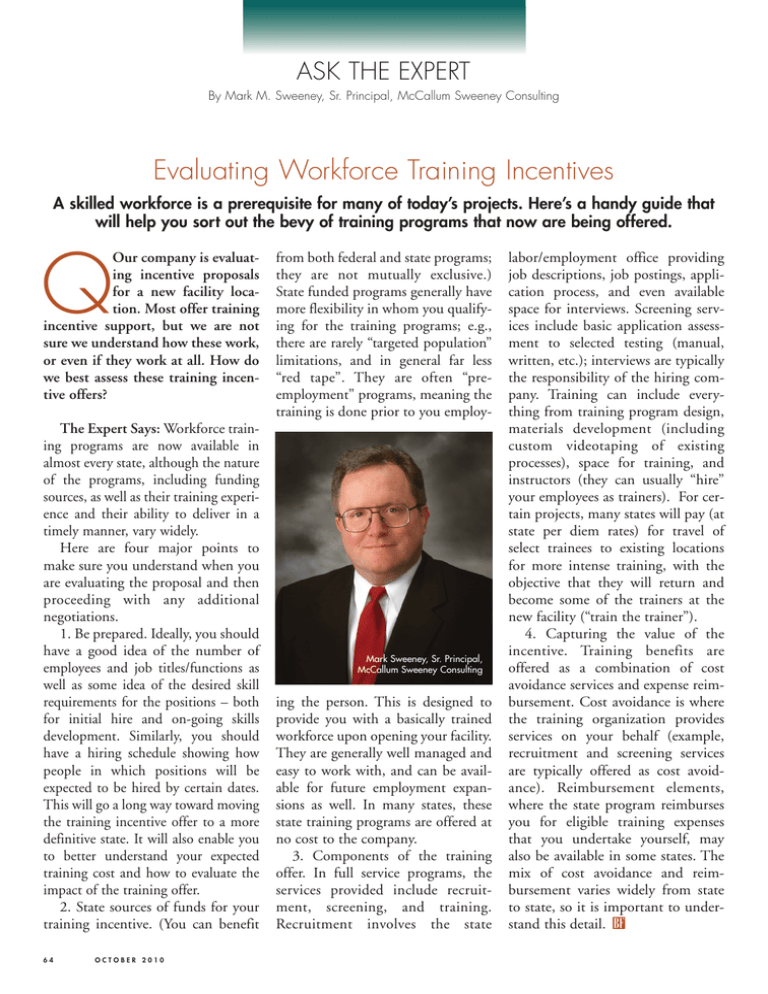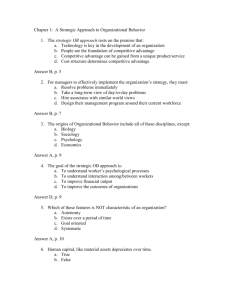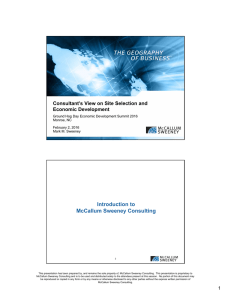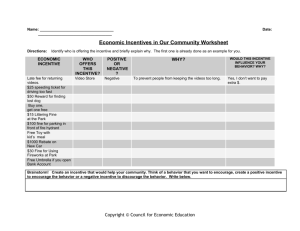Q
advertisement

ASK THE EXPERT By Mark M. Sweeney, Sr. Principal, McCallum Sweeney Consulting Evaluating Workforce Training Incentives A skilled workforce is a prerequisite for many of today’s projects. Here’s a handy guide that will help you sort out the bevy of training programs that now are being offered. Q Our company is evaluating incentive proposals for a new facility location. Most offer training incentive support, but we are not sure we understand how these work, or even if they work at all. How do we best assess these training incentive offers? The Expert Says: Workforce training programs are now available in almost every state, although the nature of the programs, including funding sources, as well as their training experience and their ability to deliver in a timely manner, vary widely. Here are four major points to make sure you understand when you are evaluating the proposal and then proceeding with any additional negotiations. 1. Be prepared. Ideally, you should have a good idea of the number of employees and job titles/functions as well as some idea of the desired skill requirements for the positions – both for initial hire and on-going skills development. Similarly, you should have a hiring schedule showing how people in which positions will be expected to be hired by certain dates. This will go a long way toward moving the training incentive offer to a more definitive state. It will also enable you to better understand your expected training cost and how to evaluate the impact of the training offer. 2. State sources of funds for your training incentive. (You can benefit 64 OCTOBER 2010 from both federal and state programs; they are not mutually exclusive.) State funded programs generally have more flexibility in whom you qualifying for the training programs; e.g., there are rarely “targeted population” limitations, and in general far less “red tape”. They are often “preemployment” programs, meaning the training is done prior to you employ- Mark Sweeney, Sr. Principal, McCallum Sweeney Consulting ing the person. This is designed to provide you with a basically trained workforce upon opening your facility. They are generally well managed and easy to work with, and can be available for future employment expansions as well. In many states, these state training programs are offered at no cost to the company. 3. Components of the training offer. In full service programs, the services provided include recruitment, screening, and training. Recruitment involves the state labor/employment office providing job descriptions, job postings, application process, and even available space for interviews. Screening services include basic application assessment to selected testing (manual, written, etc.); interviews are typically the responsibility of the hiring company. Training can include everything from training program design, materials development (including custom videotaping of existing processes), space for training, and instructors (they can usually “hire” your employees as trainers). For certain projects, many states will pay (at state per diem rates) for travel of select trainees to existing locations for more intense training, with the objective that they will return and become some of the trainers at the new facility (“train the trainer”). 4. Capturing the value of the incentive. Training benefits are offered as a combination of cost avoidance services and expense reimbursement. Cost avoidance is where the training organization provides services on your behalf (example, recruitment and screening services are typically offered as cost avoidance). Reimbursement elements, where the state program reimburses you for eligible training expenses that you undertake yourself, may also be available in some states. The mix of cost avoidance and reimbursement varies widely from state to state, so it is important to understand this detail.







